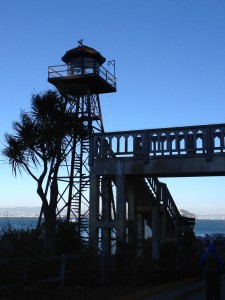
A long time ago my friend Jade Walker sent me a link (that I unfortunately no longer have) asking if Haunt Jaunts is dark tourism. I think the link was to the Institute for Dark Tourism Research, but for some reason I didn’t save it so I’m not positive about that. It could’ve been to an article about dark tourism.
What is dark tourism?
If you can believe it, Wikipedia has a page about it. Here’s how they sum it up (which they do a perfect job of):
Dark tourism (also black tourism or grief tourism) is tourism involving travel to sites associated with death and tragedy….
This includes castles and battlefields such as Culloden in Scotland and Bran Castle and Poienari Castle in Romania; sites of disaster, either natural or man made, such as Hiroshima in Japan, Chornobyl in Ukraine and the Ground Zero in New York; Auschwitz in Poland; prisons now open to the public such as Beaumaris Prison in Anglesey, Wales; and purpose built centers such as the London Dungeon, the Spirit Lake Internment Camp centre (near La Ferme, Quebec) and other sites associated with Canada’s first national internment operations. It also includes other sites of human atrocities and genocide, such as the Nanjing Massacre Memorial Hall in Nanjing and the Tuol Sleng Genocide Museum in Cambodia.
Haunt Jaunts is a form of dark tourism. It’s paranormal tourism. That means I travel to places like those listed above where bad things may have happened. But not only am I interested in the history of what happened and why, I’m interested that the places are rumored to be haunted locations.
Macabre? Yes. It’s a weird thing to do.
But it’s also very educational. There are at least 13 things you can learn by traveling to haunted places. Among them is history, but from history comes foresight. By learning lessons from the past, history helps us not repeat mistakes. Theoretically at least.
So, yes, paranormal tourism is a form of dark tourism. It’s also, as Amanda Kendle pointed out in “Dark Tourism: A Fine Line Between Curiousity and Exploitation,” delicate. Respect is of the essence when being a visitor anywhere, but most especially where suffering and tragedy has occurred.
Have you ever been to a battlefield, prison, or other site that might be classified as a dark tourism destination? Were you there because of it’s past or for its haunted reputation? (Basically, are you a dark tourist or a paranormal one?)
Courtney Mroch is a globe-trotting restless spirit who’s both possessed by wanderlust and the spirit of adventure, and obsessed with true crime, horror, the paranormal, and weird days. Perhaps it has something to do with her genes? She is related to occult royalty, after all. Marie Laveau, the famous Voodoo practitioner of New Orleans, is one of her ancestors. (Yes, really! As explained here.) That could also explain her infatuation with skeletons.
Speaking of mystical, to learn how Courtney channeled her battle with cancer to conjure up this site, check out HJ’s Origin Story.
